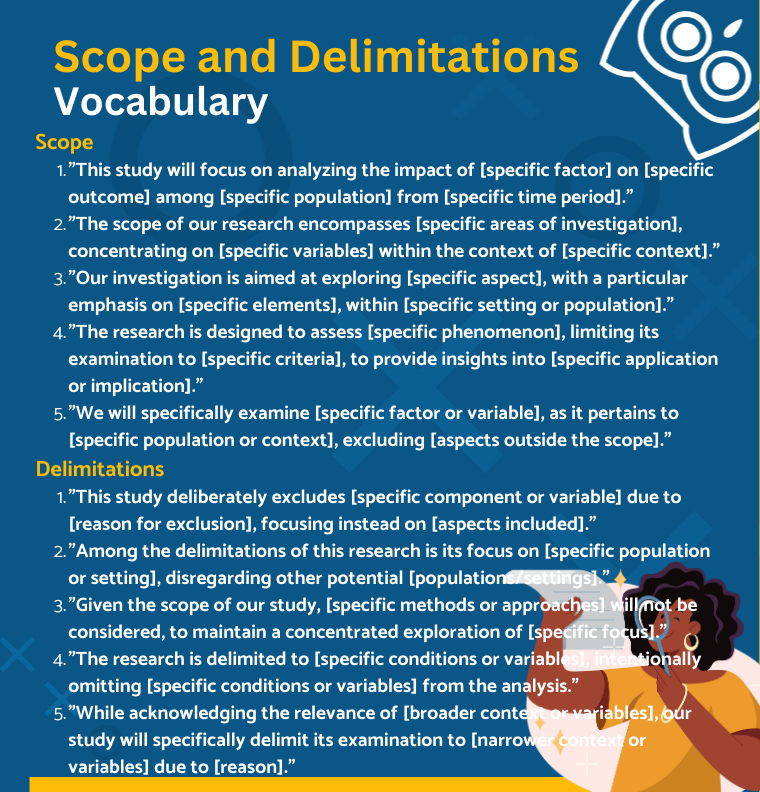Scope and Delimitations in Academic Research
Table of contents
Understanding the scope and delimitations of a study is crucial for defining its parameters and ensuring focused research efforts. What are delimitations in a research study? These components establish the boundaries within which the research will operate and clarify what the study aims to explore and achieve. This article delves into the significance of clearly defining the scope and every delimitation, how they guide the research focus, and their roles in shaping the research process. Additionally, it provides insights into determining these aspects and articulating them effectively in a research proposal or paper. Transitioning smoothly into the main discussion, let’s explore the importance of scope in research, guiding the focus.
The importance of Clearly Defining the Scope of the Study for Guiding Research Focus
The scope of research delineates its extent or range of inquiry, setting clear parameters for what the study will cover. It’s a foundational aspect that guides every step of the research process, from the formulation of research questions to the interpretation of results. Defining the scope helps in focusing the research efforts, ensuring that the study remains manageable and within realistic bounds.
Understanding the scope and limitation of the study allows researchers to allocate resources efficiently, ensuring that every aspect of the study receives adequate attention. It also helps in avoiding the common pitfall of overreaching, which can dilute the research’s impact and make findings less actionable. By setting a defined scope, researchers can more easily communicate their work’s relevance, limitations and delimitations in the research process to stakeholders, enhancing the credibility and applicability of their findings. Furthermore, a well-defined scope can facilitate a more targeted and effective literature review, laying a solid foundation for the research study.
When navigating the complexities of defining a study’s scope, researchers might seek external support to ensure their research is concise, well-structured, and impactful. A paper writing services, PapersOwl offers a spectrum tailored to meet academic research’s unique demands. Their expertise can be particularly beneficial in refining research proposals, ensuring the scope is clearly communicated and aligned with academic standards. Engaging with such a service allows researchers to benefit from professional insights, which can enhance the coherence and focus of their work. This collaboration can be instrumental in identifying the most relevant study areas and avoiding unnecessary diversions. With PapersOwl’s support, researchers can ensure their project’s scope is well-defined and compellingly presented, making a strong case for its significance and feasibility. This partnership can be a strategic step towards achieving a study’s specific objectives, ensuring it contributes valuable insights within its defined boundaries.
Examples of Elements Included in the Scope
Defining the scope of a research project is akin to drawing a map for a journey; it outlines the terrain to be explored and the boundaries within which the exploration will occur. This clarity is essential for guiding the research process, ensuring the investigation remains focused and relevant. The scope encompasses various elements, each contributing to the overall direction and integrity of the study. Let’s delve into some of these key elements:
- Research Objectives: The specific aim the study is designed to achieve.
- Geographical Coverage: The physical or virtual locations where the research is conducted.
- Time Frame: The period during which the study takes place, which could range from a few days to several years.
- Subject: The specific topics or issues the research intends to address.
- Population Being Studied: The group of individuals, organizations, or phenomena being investigated.
These components of the scope serve as critical navigational tools in the research journey. They ensure that the study remains grounded in its objectives, relevant to its intended audience or population, and manageable within its temporal and geographical constraints. By carefully defining these elements at the outset, researchers can avoid common pitfalls such as scope creep, where the study’s focus broadens uncontrollably, potentially diluting its impact and significance. A well-defined scope is instrumental in crafting a focused, coherent, and impactful research project.
Role of Delimitations in Qualitative Research
Delimitations in research examples specify the boundaries set by the investigator on what the study will not cover, distinguishing them from limitations, which are potential weaknesses in the study not controlled by the researcher. Delimitations are choices made to narrow the scope of a study, focusing on specific aspects while excluding others. In the intricate tapestry of research design, delimitations play a pivotal role in sharpening the focus and enhancing the clarity of a study. By explicitly stating what the research will not explore, delimitations help prevent the dispersion of the research efforts across too broad an area, thereby increasing the depth and specificity of the investigation. This strategic narrowing allows researchers to concentrate their inquiries on areas most likely to yield impactful insights, making efficient use of available resources and time.
One might wonder how to establish these boundaries effectively without compromising the potential breadth of discovery. Here, the expertise provided by platforms like PapersOwl, particularly their research paper writer services, becomes invaluable. Their seasoned professionals can offer guidance on crafting a research design that is both focused and flexible, assisting in identifying and justifying delimitations that enhance the study’s relevance and feasibility. Through such collaboration, researchers can balance the scope and delimitation of the study, ensuring that it remains grounded in its objectives while open to unforeseen insights.
Furthermore, acknowledging delimitations in a research paper demonstrates a researcher’s critical understanding of their study’s context and constraints, enhancing the credibility of their work. It shows a mindful engagement with the research process, recognizing that by setting deliberate boundaries, the study can delve more deeply and meaningfully into its chosen area of inquiry. Thus, when thoughtfully articulated with support from research paper writing help, like that offered by PapersOwl, delimitation in research becomes a testament to the rigor and integrity of its effort.
Examples of Delimitations in Research
Delimitations in research are akin to the guardrails on a highway; they keep the investigation on track and prevent it from veering into less relevant or overly broad territories. Below are some examples of how researchers can apply delimitations to fine-tune their investigations:
- Restricting the Study to Certain Age Groups: Focusing on a specific demographic, such as teenagers or the elderly.
- Geographic Locations: Limiting the research to a particular country, city, or region.
- Specific Periods: Studying a phenomenon during a particular time frame, ignoring other periods.
Setting these research delimitations is not about narrowing the vision of the research, but rather about sharpening its focus. It allows for a more thorough and nuanced exploration of the chosen subjects, leading to more precise findings and general delimitation meaning in research. Delimitations highlight the researcher’s awareness of the study’s scope and commitment to conducting a focused, manageable investigation.
Determining the Scope and Delimitation
Identifying the scope and delimitations of your research involves understanding the research problem deeply and recognizing what is feasible within the constraints of time, resources, and data availability. Strategies for determining these include:
- Reviewing existing literature to identify gaps and opportunities.
- Consulting with experts or advisors to refine research questions.
- Considering data availability and methodological constraints.
Balancing the scope and delimitations involves ensuring the research is neither too broad, unmanageable, nor too narrow, limiting its significance. Crafting a research project that strikes the right balance between breadth and depth is a nuanced task. It requires a researcher to be acutely aware of where their study begins and ends, what it encompasses, and what it intentionally leaves out. This equilibrium is not found in isolation but through a diligent exploration of the field and an understanding of how to best position one’s work within it. A key step in this process is identifying and sourcing relevant literature and data, which can significantly influence the scope of research.
Leveraging resources such as PapersOwl’s guide on how to find sources for research papers can prove invaluable in this phase. This platform provides insights into locating credible and relevant information, ensuring that researchers build their work upon a solid foundation of existing knowledge. By understanding how to navigate the vast, effective ocean of available data, researchers can make informed decisions about the direction and limits of their study. This meticulous preparation is crucial for defining the scope and delimitations and justifying them within the context of the research proposal or paper. It demonstrates a researcher’s commitment to rigor and depth, showing that their choices are informed by a comprehensive understanding of the subject and its existing body of literature.
Writing the Scope and Delimitations Section

Articulating the scope and delimitations in a research paper or proposal is crucial for setting clear expectations. It should clearly define delimitations and what the study will and will not cover, providing a rationale for these choices. Effective wording and structure involve:
- Stating the research objectives and questions upfront.
- Describing the research methodology, data collection methods and analysis.
- Outlining the geographical coverage, time frame, and subject matter.
- Clearly stating the delimitations and the reasons behind them.
The presentation of the scope and delimitations within a research document not only guides the readers through the intentions of the research but also establishes a framework for evaluating the findings. It’s a critical section where transparency and precision are paramount, allowing the audience to grasp the extent of the study and the rationale behind its boundaries. This transparency is essential for the credibility of the research, as it demonstrates a conscious and deliberate effort to focus the investigation and acknowledges the existence of boundaries that the study does not cross.
To ensure clarity and impact, this section should seamlessly integrate with the overall narrative of the research proposal or paper. Researchers are advised to avoid jargon and overly technical language, making the research scope and delimitations accessible to a broader audience. This includes a layperson who may not have deep expertise in the field but an interest in the study’s outcomes. Additionally, it is beneficial to highlight how the defined study scope and delimitations contribute to addressing the research problem, filling knowledge gaps, or exploring uncharted territories.
Moreover, this part of the document offers an opportunity to discuss how the chosen delimitations enhance the study’s focus and depth. By justifying the exclusions, researchers can address potential critiques head-on, reinforcing the methodological choices and underscoring the study’s contribution to the field. This careful articulation ensures that the research is perceived as a well-thought-out endeavor, grounded in a strategic approach to inquiry.
Conclusion
The scope and delimitations of a study are foundational elements that guide the research process, setting clear boundaries and focusing efforts. By defining these aspects clearly, researchers can provide a clear roadmap for their investigation, ensuring that their work is both manageable and relevant. By consciously deciding what to exclude from the study, researchers can intensify their focus on the chosen subject, ensuring that the research efforts are concentrated where they are most needed and can be most effective. These self-imposed boundaries are critical for maintaining the study’s coherence and depth. This clarity not only aids in conducting the research but also in effectively communicating its implications, limits, and outcomes.






